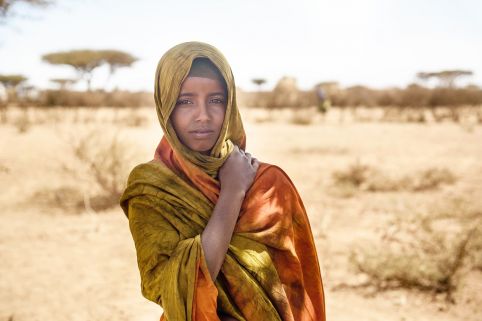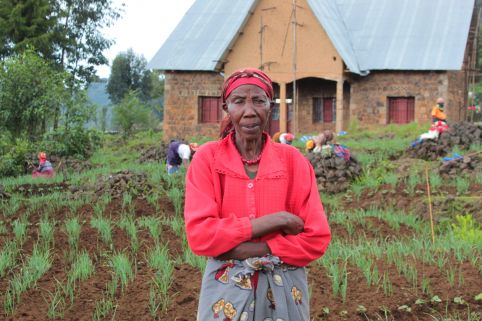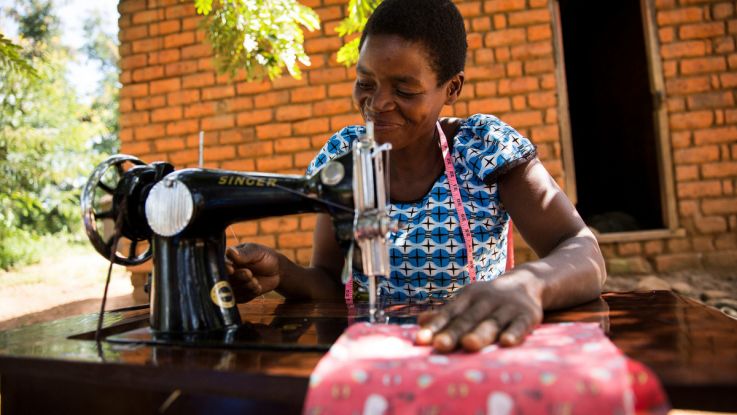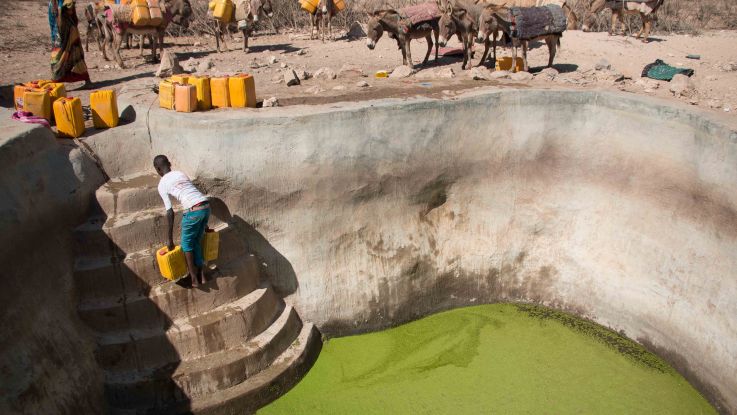Climate change has devastating impacts for the poorest people in the world including women and girls.
Extreme patterns of weather - caused by rising global temperatures - are destroying livelihoods and displacing millions of communities from their homes. Find out more about climate change, its causes, and ActionAid's charity work helping women and girls to prepare for and adapt to the effects of climate change.
About climate change and global warming
Unpredictable seasons, rising sea levels and erratic rainfall, which contribute to floods, droughts and crop failures, mean that millions of people - who are already struggling to survive - are finding it even more difficult to grow food, get clean water and access shelter.
The poorer people are, the harder it is to recover from failed harvests, destroyed homes, water scarcity and deepening health crises.
The right to adequate food, water, health and housing are basic human rights.1 This is why ActionAid works with women, girls and communities across the world to not only help alleviate the effects of climate change but also fight for climate justice through research, campaigning and advocacy.
From providing sustainable farming solutions to lobbying governments to end harmful development practices that drive climate change, we're working every day to end climate-driven poverty.

Nelia Binda Bvuma, Makoni District, Manicaland Province of Zimbabwe .
What is a climate?
Climate is an average pattern of weather conditions such as temperature, humidity, air pressure measured over a longer period of time such as 30 years, in a particular place. Climates are specific to geographical regions such as tropical climates, desert climates or mediterranean climates.2
What is weather?
Weather is the short-term or day-to-day difference in the state of earth’s atmosphere and can be measured in terms of temperature, humidity, air pressure and rainfall.3
What is climate change?
Climate change is a significant or abnormal difference in the long-term, average weather pattern for a particular region or for the Earth as a whole and the effects it has on the Earth.
What causes climate change?
Climate change can come about from natural factors like volcano activity, changes in the sun and from processes inside the Earth’s core.
But research has shown that the current climate change is largely a result of human activities since the mid-20th century.4
Human activities such as burning oil or gas and cutting down forests, is increasing the concentration of greenhouse gases like carbon dioxide that trap heat in the Earth’s atmosphere.
What’s the evidence for climate change?
Global temperatures have been rising and are at their highest since records began.
Since 1900, the average air temperature has increased by about 0.8°C and the four warmest years on record have occurred since 2015.5
As a result, our planet’s increasing temperatures are melting ice caps in the Arctic, raising sea-levels, changing rainfall patterns and creating other extreme climate events like hurricanes and cyclones.6
If the world is getting warmer, why are UK summers still not very warm?
Day to day weather is different to climate. Global warming is measured and averaged over a long period of time. This means we can still have cold winters and not very warm summers on a year to year basis. Climate affects local weather, which is why the UK is experiencing more and more heatwaves.7

Taysa village in Somaliland suffers from severe drought .
What is the relationship between climate change and poverty?
Changes in rainfall, rising sea levels, and extreme climate events are disruptive and affect the homes and livelihoods of people around the world.
From the drought in Somaliland to flooding in Bangladesh, climate-change related crises are increasing death, displacement, hunger and unemployment.
70% of the world’s poor depend on natural resources like land for their food and livelihood. Over 1.3 billion people in the global south are relying on agricultural land that is slowly degrading.8
Long-term changes in climate can cause droughts, floods and increase the salt in soil, which affect water supply, farming crops and rearing animals. This affects food production, spread of disease and displacement of communities.
The poorer people are, the harder it is for them to recover from failed harvests, destroyed homes, dwindling water supplies and deepening heath crises.
Not only that but farmers in developing countries have limited options for alternative ways to produce their food and income and are often excluded from wider economic development.
How does climate change displace people?
Climate change can force mass migration when people’s food and water supplies become scarce or when their homes and livelihoods are destroyed.
An average of 26 million people flee their homes every year due to climate-related disasters.9 Of these displaced people, 80% are women.10
The majority of climate-related displacement (such as in instances of severe drought or floods) is internal, as those affected by extreme weather conditions remain within their country borders.
How does climate change affect women and girls?
Climate change affects different people in different ways including women and girls.
Climate change is a gender issue because women and girls living in poverty are particularly vulnerable to the effects of climate change due to their given social roles, and their status in society.
Women and girls often bear the heaviest burden of climate change as majority of the world’s poor are women. They have fewer rights, are denied critical access to land, inheritance and money.
70% of the 1.2 billion people, suffering from hunger in the world, are women and girls.13
Most of the world’s estimated 1 billion rural women rely on agriculture or natural resources for their livelihoods.14 This dependency on land and farming makes them vulnerable to the impacts of climate change.
Women and girls are more likely to be pulled out of school to work on the family’s land and are forced into marriage as a desperate measure when food is scarce.
When climate change forces women and girls from their homes, they become incredibly vulnerable to early marriage, adolescent pregnancy, rape and trafficking.
Future climate-related disasters are inevitable and will drive women and girls even further into poverty.
Read more about how climate-change related events are affecting women and girs around the world.
ActionAid's charity work taking action on climate change
Helping to reduce climate change’s impact
For many years, ActionAid has worked with communities to strengthen their resilience to climate change. We support developing countries to cope with climate impacts and transition to greener pathways.
Across the world, we support hundreds of thousands of people who rely on farming for income and food. Through innovative farming methods and tools like table gardening, salt-resistant seeds and climate-resilient livestock, we help communities adapt to erratic weather patterns.
We also look for sustainable solutions in all aspects of our work. For example, in Nepal we teach women and girls to make plastic-free, reusable sanitary pads. This enables them to have easy access to safe sanitary products, while helping to protect the environment.
Demanding climate justice
We have called on governments and the United Nations to put in place policies and actions that protect citizens from climate change impacts and to end harmful development models that are driving dangerous climate change.
Our offices around the world are continuing to influence national climate policies. We are developing reports, briefings and publications which can be used to strengthen global understanding of the climate crisis.
We focus on climate justice and recognise the responsibility of wealthy countries in leading rapid climate action.
Footnotes
- 1International Covenant on Economic, Social and Cultural Rights". www.refworld.org.
- 2 Shepherd, Dr. J. Marshall; Shindell, Drew; O’Carroll, Cynthia M. (1 February 2005). "What’s the Difference Between Weather and Climate?". NASA. Retrieved 13 November 2015.
- 3http://glossary.ametsoc.org/wiki/Main_Page
- 4https://www.theccc.org.uk/tackling-climate-change/the-science-of-climate-change/climate-variations-natural-and-human-factors/
- 5https://www.theguardian.com/environment/2019/feb/06/global-temperatures-2018-record-climate-change-global-warming
- 6https://climate.nasa.gov/evidence/
- 7https://www.theguardian.com/environment/2019/aug/02/record-heatwave-made-much-more-likely-by-human-impact-on-climate
- 8https://www.un.org/development/desa/dspd/wp-content/uploads/sites/22/2018/05/9.pdf
- 9https://reliefweb.int/report/world/climate-migrants-might-reach-one-billion-2050
- 10https://www.bbc.co.uk/news/science-environment-43294221
- 11https://static1.squarespace.com/static/559d276fe4b0a65ec3938057/t/55f6fe81e4b02545cc71df30/1442250369603/wen-briefing-net2.pdf
- 12Calculated by WEN from Aguilar, L. (2004) Climate change and disaster mitigation. Gender makes the difference. Gland: IUCN; and Global Humanitarian Forum (2009) Human Impact Report. Anatomy of a silent crisis. Geneva: Global Humanitarian Forum
Page updated 6 February 2025












